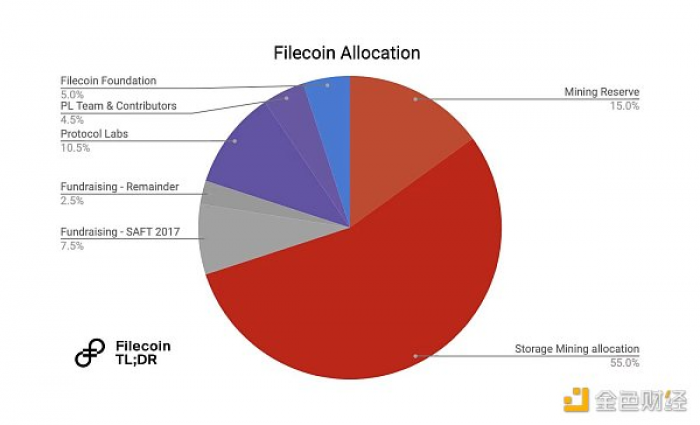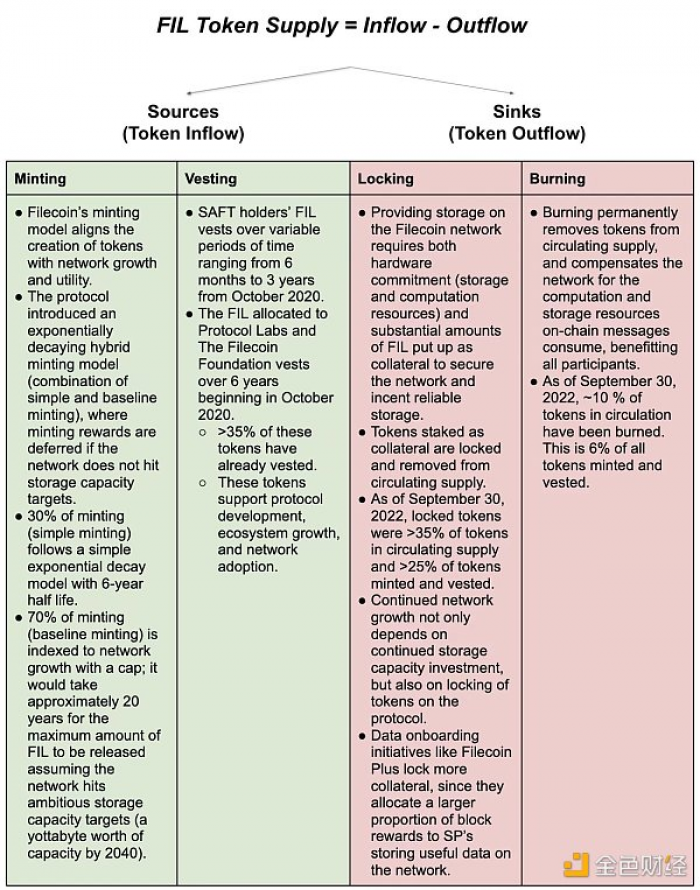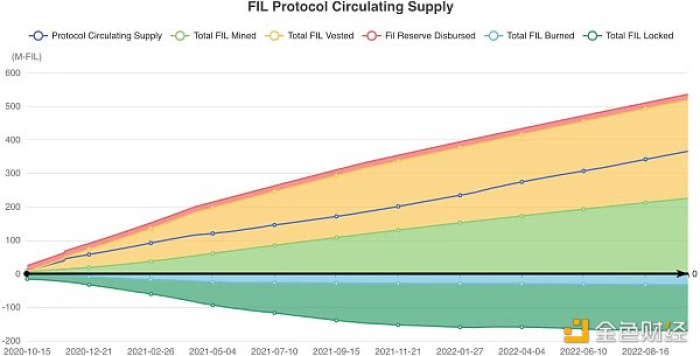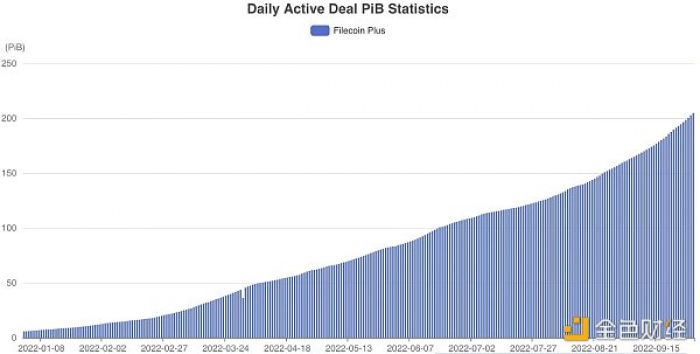Since the distributed storage network Filecoin released three major project updates for 2023 (FVM, data computing, retrieval market) last week, FIL has continued to break its "ceiling" in the past week. The latest price of FIL has exceeded 9 USDT, 24 The hourly increase reached 21.35%. Next, Odaily Planet Daily will take everyone to understand the impact of the Filecoin token economy on token holders and the future ecology.
Introduction to Filecoin
Launched in October 2020, the Filecoin network introduces an incentive layer to the IPFS protocol and enables open services for data. Today, the Filecoin network is known primarily as an open service storage. However, an early article summarizing the direction of the network laid out a larger vision for Filecoin that also included "infrastructure for storing, distributing, and transforming data."
Filecoin’s “main plan” to execute this vision is to first accumulate a large amount of hardware resources (storage capacity and computing power). This is important because the only way Web3 infrastructure can reliably replace (or even more than compete with) traditional cloud storage is if it can operate at orders of magnitude and scale beyond current offerings. Although no Web3 protocol has achieved this yet, some progress has been made.
Furthermore, to drive long-term demand for network resources (capacity, retrieval, and computational power), it is critical to bootstrap the network with efficient data and develop software and tools to enable computational and composable services on top of the data. Ultimately the demand for these services will become the basis for a robust economy on top of the Filecoin blockchain.
Filecoin’s token economy was designed with this long-term vision in mind and helps incentivize the rapid growth and development of the network. To date, the network has more than 16 EiB of committed storage capacity, with the explosive growth of the ecosystem driving demand for network resources. This growth and continued success is due to the efforts of the Filecoin community, an interconnected network of storage clients, developers, storage providers (SPs), ecosystem partners, and token holders.
Filecoin token
This global digital economy also requires a single valid currency to conduct transactions. Since Filecoin is a permissionless marketplace with cryptographically verifiable goods, the design constraint can only be achieved through the native utility token Filecoin. FIL tokens have multiple functions:
Pay for messages on the chain.
as collateral. Create economic incentives for long-term reliable data storage and secure blockchains and subnets or shards after Interplanetary Consensus (IPC: Consensus Lab flagship project) comes into effect.
Burn to regulate shared resources (block space).
Unlike other storage networks, Filecoin tokens are primarily focused on incentivizing reliable services and promoting on-chain economics. The storage market exists off-chain, but messages containing cryptographic proofs of storage are anchored on-chain. Crucially, this means that tokens can grow in value without placing undue stress on users of the network’s various services (storage, retrieval, computation, etc.) due to increased utilization (i.e. demand for block space ), token holders can still benefit from FIL consumption.
Token economy for token holders
Filecoin Token Distribution
Filecoin’s cryptoeconomic structure helps ensure that participants’ value appreciation is aligned with the long-term utility of the protocol. Therefore, the purpose of Filecoin's initial distribution at network launch is to support a protocol that incentivizes sustainable value creation.

Source: Filecoin Spec.
According to current protocol specifications, up to 2 billion FIL will be created. Of this, 70% is allocated to storage and related services (i.e. minting tokens to reward storage providers), and 20% (granted over 6 years starting in October 2020) is allocated to Protocol Labs and the Filecoin Foundation to support network development , adoption and ecosystem growth. The remaining FIL is allocated to SAFT investors, vesting beginning in October 2020, with terms ranging from 6 months to 3 years.
2 billion FIL is the maximum amount that can theoretically be minted and vested. However, this may not be the amount of FIL that ends up in the network's circulating supply:
The 300 million FIL held as a mining reserve requires a protocol upgrade before it can be mined, meaning it is up to the community to decide how much should be released.
The growth of the network requires the use and consumption of tokens, thus reducing the available token supply. As of the end of September 2022, approximately 520 million FIL had been minted or vested. Of this, approximately 70% is in circulation, as large amounts of FIL are burned (permanently removed from circulation) due to network transaction fees, or locked as collateral to secure the network and incentivize reliable storage. Token emission rates (vesting and minting) are expected to gradually decrease as the network matures, as Filecoin has a limited vesting schedule and a minting model where emissions are tied to network growth.
Token Supply: Net Inflows or Outflows
Token holders understanding the net inflows or outflows that determine the token supply will help them understand the relative purchasing power of the tokens.

Simply put, minting, vesting, locking, and burning contribute to the net inflow or outflow of tokens in the circulating supply. Here’s how the Filecoin token supply has evolved since the launch of the mainnet.

Source: Starboard Ventures. Data as of September 30, 2022. This chart represents historical data only. Because the circulating supply of Filecoin is affected by market inputs, it cannot be accurately predicted.
Currently, the network is expanding. Token vesting from the Filecoin Foundation and Protocol Labs supports the development and growth of the ecosystem, while block rewards from storage providers reward transactions and storage capacity for coming online. This provides token holders with a huge opportunity to participate in the growth of the ecosystem, as they can lend money to storage providers (SPs), facilitate storage provider demand for FIL, and share in the resulting network rewards. In this way, token holders can retrieve token emissions while supporting network growth and advancing the Filecoin vision.
Filecoin Ecosystem Roadmap: Impact on Token Holders
Within the Filecoin ecosystem, continued improvements in user programmability, data logability, data retrieval, scalability, and computation will be implemented over the next 3 quarters. These initiatives should have a positive impact on token holders by supporting client needs, unlocking various network use cases, and ultimately driving usage of the token. Some of these important improvements and their potential economic impact are discussed below.
Filecoin Virtual Machine (FVM)
The Filecoin Virtual Machine unlocks endless possibilities, from programmable storage primitive systems, to cross-chain interoperability bridges, to data-centric decentralized autonomous organizations (DAOs) and Layer 2 solutions. In a nutshell, this means smart contracts and user programmability are coming to Filecoin. Expected to be released in the first half of 2023, this network upgrade should have a positive impact on token holders, as it may increase the use cases of FIL and may affect the "outflow" component of the circulating supply equation (FIL locked and burned).
FVM and the outflow portion of the token supply
As long as an operation or utility exists on the network, FIL tokens will be consumed (burned) to compensate for the computational and storage resources consumed by chain messages. The introduction of smart contract functionality may increase the demand for block space, resulting in an increase in FIL burned. This token consumption rate is in the hands of the community as network participants compete for on-chain resources.
Additionally, FVM protocol upgrades can increase the amount of FIL committed and/or locked. Currently, the majority of FIL locked on the network comes from storage provider collateral. FVM introduces the possibility of locking large amounts of funds to support various smart contract applications. DeFi protocols are just a subset of applications that can leverage Filecoin’s efficient proof-of-work chain, not only increasing token consumption but also generating new use cases for locking/locking FIL.
FVM is unique in that it brings new power to the Filecoin network. While today you can contract with a storage provider to store your data, with FVM, additional rules, automation, and composability with other services such as DeFi can be added. As other components of the Filecoin roadmap are implemented (retrieval market, data computing, etc.), we hope that FVM can leverage Filecoin’s basic facilities to facilitate the implementation of more complex products, thereby promoting wider network adoption.
Filecoin Plus and Data Onboarding
Filecoin Plus (FIL+) is a practical solution designed to incentivize efficient use of the Filecoin network. Since it is algorithmically difficult to distinguish between real useful data and generated random data, FIL+ introduces a social trust layer into the network. In the FIL+ program, clients that pass the verification process are granted a new resource, DataCap, which they can use to conduct storage transactions with the storage provider (SP). SPs are incentivized to enter into storage agreements with customers using DataCap because FIL+ transactions increase the number of block rewards they receive compared to regular (non-FIL+) transactions, or by submitting storage capacity to the network. To receive these additional rewards from FIL+, storage providers post more collateral (approximately 10x the collateral of non-FIL+ storage sectors) and lock more tokens on the network.
So far, we are seeing strong growth in data from FIL+ customers, which shows that the number of effective Data Onboarded (data onboarded: connecting offline and online data through tags, such as matching of B2B or B2C data sets) is increasing. Increase.

Source: Starboard Ventures. Data as of September 30, 2022.
From a token economics perspective, continuation of this trend is likely to increase the number of tokens locked on the network and reduce the supply of tokens in circulation. What’s more, as the Filecoin network evolves toward its mission of storing valid data, token consumption and utilization will grow.
Interplanetary Consensus Upgrade (IPC: ConsensusLab Flagship Project)
IPC is an upcoming network upgrade designed to increase the use cases that Filecoin can support while improving the network’s scalability, throughput, and finality, and is an exciting blockchain innovation. By scaling the chain horizontally via subnets (shards), IPC also has potential impact on the cryptoeconomics and may increase:
The amount of FIL burned also reduces gas charges for users due to increased scalability and FVM utilization.
The amount of FIL locked (or staked) as collateral to secure the subnet.
Support FIL consumption requirements for shards that customize on-chain use cases.
Summarize
As a new type of data storage and application network, Filecoin's mission is to create a decentralized, efficient, and robust foundation for social information. The sheer number of developments in the Filecoin ecosystem that support this mission will have a positive impact on token holders. The protocol’s token economy is designed to reward long-term participation and contribution to the network. Community participants can increase their profits by understanding the token economy, specifically the sources of token inflows and outflows that underpin the token economy. Going forward, continued improvements to the protocol may lead to new and exciting use cases for the network and token, potentially further driving token holder participation and actively driving the value proposition of this rapidly growing ecosystem. .
Post time:2023-02-21

